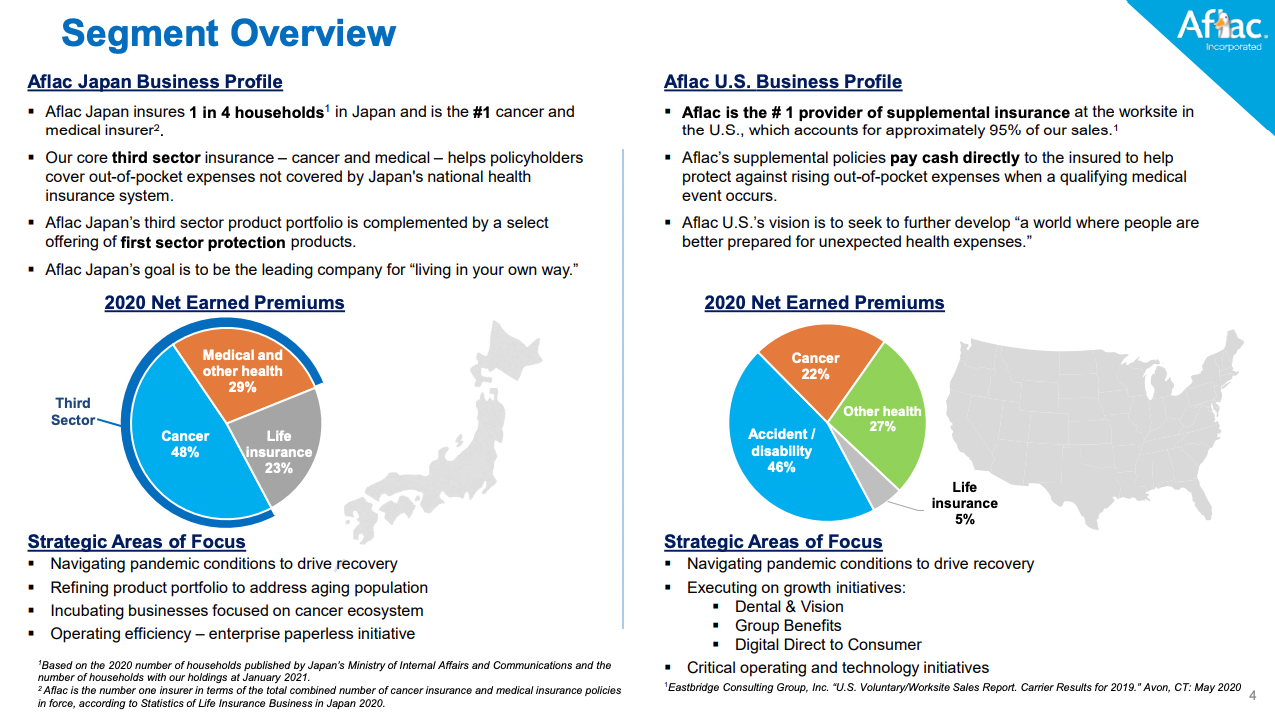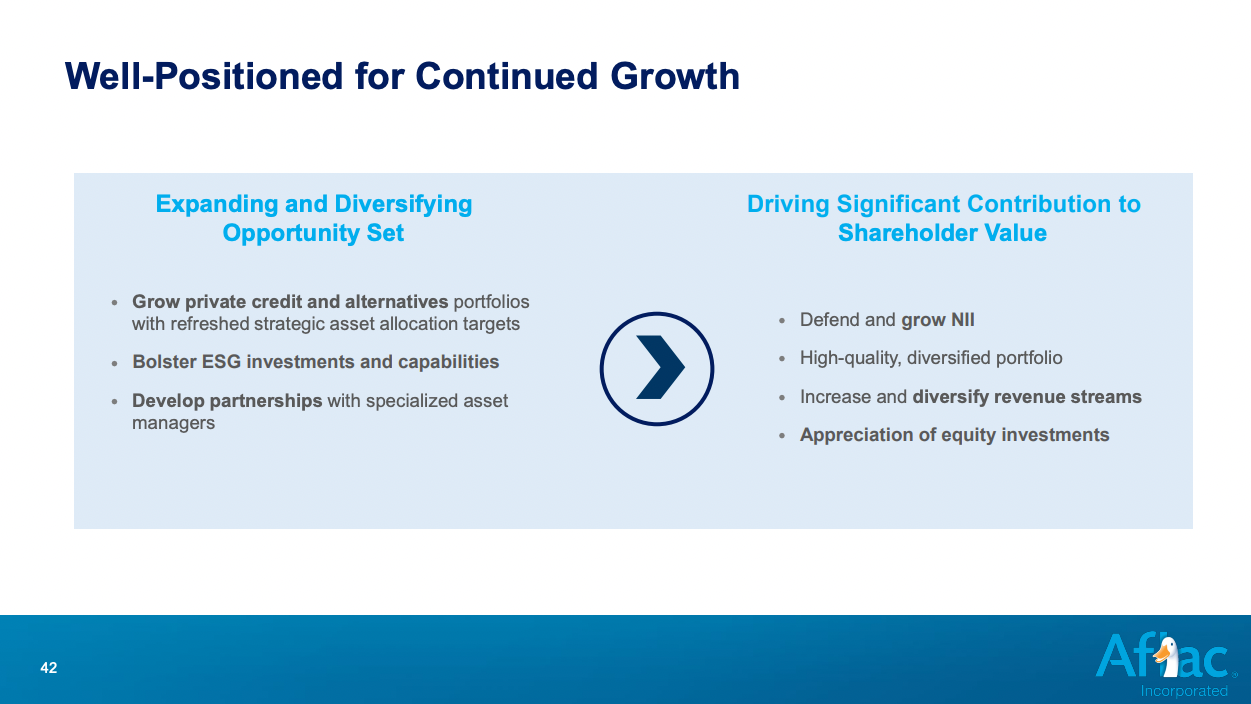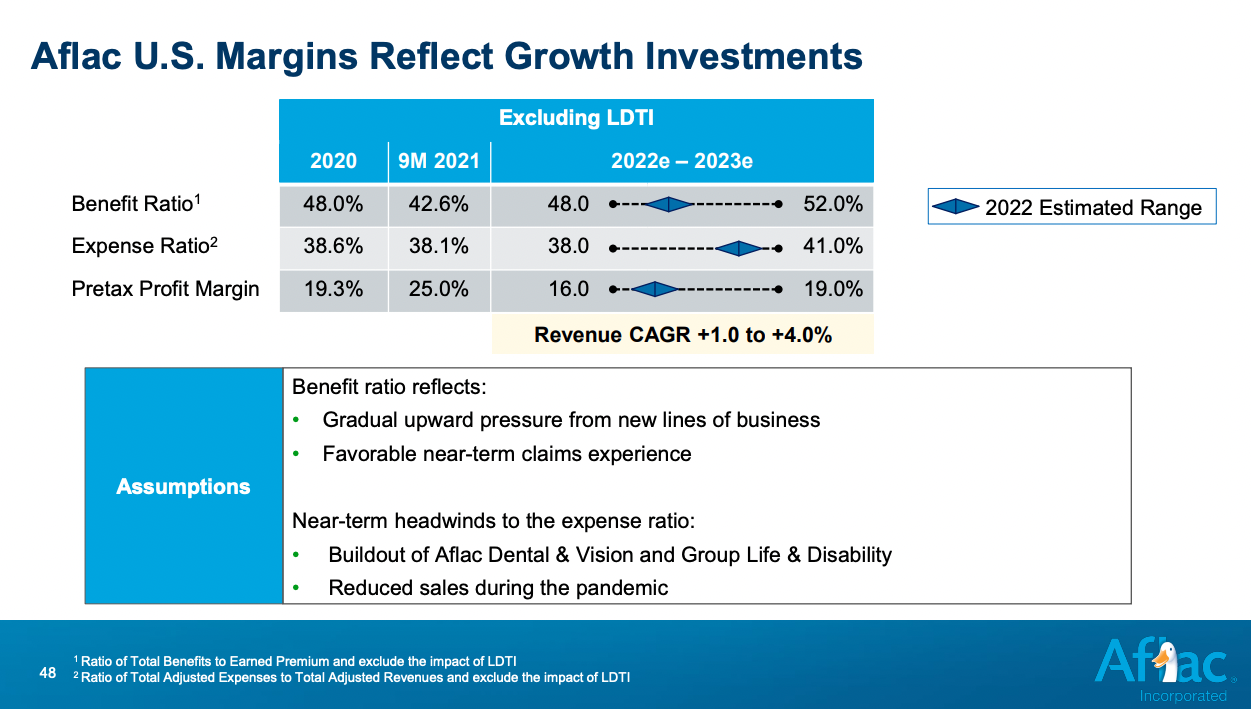Dividend Aristocrats In Focus: Aflac
Insurance can be a great business. Not only do insurers collect revenue from policy premiums, but they also make money by investing the accumulated premiums not paid out in claims, known as the float.
Even legendary investor Warren Buffet sees the value of insurance stocks –his investment conglomerate Berkshire Hathaway (BRK-A) (BRK-B) owns GEICO, General Re, and more.
High profitability allows many insurance companies to pay dividends to shareholders, and raise their dividends over time. For example, Aflac (AFL), has increased its dividend for 40 years in a row.
This means the company qualifies as a Dividend Aristocrat – a group of 65 companies in the S&P 500 Index, with 25+ consecutive years of dividend increases.
This article will take an inside look at Aflac’s business model, and what drives its impressive dividend growth.
Business Overview
Aflac was formed in 1955 when three brothers — John, Paul, and Bill Amos — came up with the idea to sell insurance products that paid cash if a policyholder got sick or injured. In the mid-twentieth century, workplace injuries were common, with no insurance product at the time to cover this risk.
Today, Aflac has a wide range of product offerings, some of which include accident, short-term disability, critical illness, hospital indemnity, dental, vision, and life insurance.
(Click on image to enlarge)

Source: Investor Presentation
The company specializes in supplemental insurance, which pays out to policyholders if they are sick or injured, and cannot work. Aflac operates in the U.S. and Japan, with Japan accounting for approximately 70% of the company’s premium income. Because of this, investors are exposed to currency risk.
Aflac’s earnings will fluctuate, in part based on exchange rates between the Japanese yen and the U.S. dollar. When the yen rises against the dollar, it helps Aflac because each yen earned becomes more valuable when it is reported in U.S. dollars.
Aflac’s strategy is to increase premium growth through new customers, as well as increase sales to existing customers. It is also investing to expand its distribution channels, including its digital footprint, in the U.S. and Japan.
Aflac continues to perform well overall. On November 15th, 2021, Aflac declared a $0.40 per share quarterly dividend, marking a 21.2% increase and the company’s 40th straight year of increasing its payment.
On October 27th, 2021, Aflac released Q3 2021 results. For the third quarter, the company reported $5.2 billion in revenue, representing an 8.8% decrease compared to Q3 2020.
Net earnings equaled $888 million or $1.33 per share compared to $2.5 billion or $3.44 per share in Q3 2020. On an adjusted basis, earnings-per-share equaled $1.53 versus $1.39 prior.
For the nine months of 2021, Aflac generated $16.7 billion in revenue, representing a 2.7% increase compared to the nine months of 2020. Net income equaled $3.3 billion or $4.82 per share in 2021, compared to $3.8 billion or $5.31 per share in 2020. However, this included a significant tax release benefit. On an adjusted basis, earnings-per-share equaled $4.66 versus $3.88 in 2020, which still represented a growth of 20.1% for 2021.
Growth Prospects
From 2007 through 2020, Aflac was able to grow earnings-per-share by an average compound rate of 8.8% per year, although part of that improvement is tax reform-related. Also, keep in mind that the Yen was generally weakening against the dollar for a good amount of the last decade. Results for 2020 were especially impressive amid the pandemic.
(Click on image to enlarge)

Source: Investor Presentation
In Japan, Aflac wants to defend its strong core position, while further expanding and evolving to customer needs. To this point, Aflac Japan is expanding its offerings of “third-sector” products. These include non-traditional products such as cancer insurance, as well as medical and income support.
Aflac has enjoyed strong demand in Japan for third-sector products, due to the country’s aging population, and declining birthrate.

Source: Investor Presentation
Meanwhile, in the U.S., Aflac believes it has a long way to go to penetrate the market. While the brand name is well-known, only a small fraction of the U.S. working population has access to Aflac and an even smaller fraction actually purchases Aflac – under 5% of the working population.
Aflac has two sources of revenue: income from premiums and income from investments. On the premium side, this is generally sticky with policy renewals making up the bulk of income. However, Aflac operates in two developed markets where we would not anticipate seeing outsized growth in the business.
The other lever available is on the investment side, where the vast majority of the portfolio is in bonds. Here there is a possibility for income improvement should rate rise in the future, although lower rates have been persistent. In addition, the share repurchase program has been an important factor as well and we believe it will continue to drive earnings-per-share.
All of these items – premium growth, higher rates, and repurchases – were challenged to some degree by the COVID-19 pandemic. However, the company has proven to be quite resilient. We are forecasting another uptick in 2022 earnings – to $5.26 per share – to go along with a 4% annual growth rate over the next five years.
Competitive Advantages & Recession Performance
Aflac has many competitive advantages. First, it dominates its niche. It operates in supplemental insurance products and is the leading company in that category. The company also has a strong brand, its business model has low capital expenditure requirements, and it sells a product that enjoys steady demand.
Aflac’s strong brand is a key competitive advantage. Competition is intense in the insurance industry, considering the commodity-like nature of the products. To retain customers and attract new customers, Aflac invests heavily in advertising.
Aflac is also a recession-resistant company. It remained profitable even during the Great Recession:
- 2007 earnings-per-share of $1.64
- 2008 earnings-per-share of $1.31 (-20% decline)
- 2009 earnings-per-share of $1.96 (49.6% increase)
- 2010 earnings-per-share of $2.57 (31.1% increase)
Notably, Aflac had a tough year in 2008, which is understandable given the deep recession at the time. However, its earnings-per-share came roaring back in 2009 and 2010.
Valuation & Expected Returns
Over the last decade shares of Aflac have traded hands with an average P/E ratio of roughly 10 times earnings. We believe this is more or less fair value for the security, considering that many insurers trade at a comparable multiple. This lower average valuation multiple allows for the robust share repurchase program to be more effective. Ongoing owners are much better served if the company is buying out past partners at 10 times earnings as compared to say 15- or 20-times earnings.
Based on 2022 expected earnings-per-share of $5.26, shares are presently trading hands at 11.5 times earnings. As such, this implies a small annual valuation headwind (-3.4%), should shares revert to 10 times earnings.
In addition, the 4% growth rate and 2.6% starting dividend yield should aid in shareholder returns. When all three components are put together, this implies the potential for 3.2% annualized returns.
Importantly, regardless of anticipated returns, Aflac’s dividend appears very safe. With an expected dividend payout ratio of 30% for 2022, Aflac’s dividend appears to be secure, with room for future increases even if EPS growth slows.
Final Thoughts
Aflac is a high-quality company, with a profitable business and a strong brand. The company has increased its dividend for 40 years in a row and should continue to do so, thanks to a low payout ratio and future earnings growth. While Aflac does not have the highest yield at 2.6%, it offers steady dividend increases and a highly sustainable payout.
In addition, shares are presently trading higher than the company’s historical valuation, resulting in a low total return expectation. The security earns a hold rating.
Disclaimer: Sure Dividend is published as an information service. It includes opinions as to buying, selling and holding various stocks and other securities. However, the publishers of Sure ...
more


